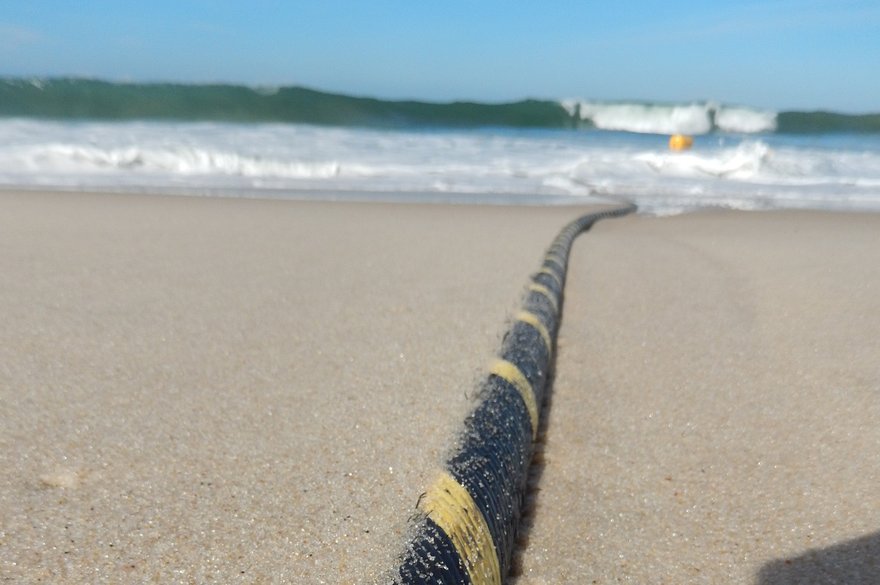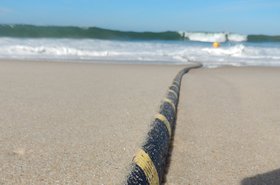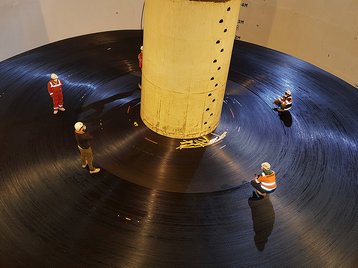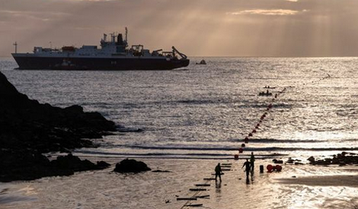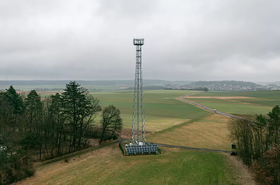Understanding the oceans is critical to help understand our planet. It’s also key to understanding and measuring climate change and the changing patterns of the ocean that result from rising temperatures and melting ice caps.
Of the 400 or so subsea fiber cables in operation today, cables dedicated to carrying scientific data number in the dozens.
However, a number of upcoming subsea cables are looking to marry commercial cables carrying regular Internet traffic with sensors that could provide researchers with critical information about the status of our oceans and provide an important new source of ocean and climate data.
Fiber cables: good for science, if rarely deployed
The first subsea telegraph cables date back to the mid-1800s, with the first fiber cable going live in the 1980s. And researchers have long understood the potential use of undersea communication cables for scientific purposes.
The Dumand project (Deep Underwater Muon And Neutrino Detector project) was an early example of dedicated science cables. The system proposed placing an underwater neutrino telescope in the Pacific Ocean off the coast of Hawaii, 5km beneath the surface. The Project existed from about 1976 through 1995, but was never completed. The hardware was donated to other underwater neutrino projects.
“My whole career has been partly dominated by trying to measure large scale ocean temperature using acoustic transmissions through the ocean to infer that temperature,” says Professor Bruce M. Howe, Research Professor at the Department of Ocean and Resources Engineering within the University of Hawaii’s School of Ocean and Earth Science and Technology (SOEST). “My goal is to get more acoustics on all these cable systems to ultimately come up with the basin-scale system that can make these temperature measurements on a routine basis.”
There are few purpose-built science cables, but scientists also use retired commercial cables that have been moved and/or repurposed for research projects. The Hawaii end of the retired HAW-4 cable is now being used for the ALOHA Cabled Observatory and is managed by Howe. The NPS Pt Sur cable runs 50km from Point Sur to Sur Ridge and is a retired US Navy acoustic cable operated by a naval post-graduate school.
“Typical telecom submarine cables are designed to transport data and don’t have environmental sensors meaning they’re not intended to measure undersea temperature, pressure, vibrations, and so on,” says Brian Lavallée, senior director of solutions marketing at Ciena. “This limits the reusability of telecom cables as scientific cables, unless the purpose is to transport scientific data between two locations, such as shore-to-shore communications."
Underwater telescopes make up a notable proportion of the dedicated and purpose-built science cables in the world. The Cubic Kilometre Neutrino Telescope (KM3NeT) aims to build on the previous Antares project off the coast of France as well as the Italian Nemo and Greek Nestor neutrino telescope projects (both deployed prototypes but were never fully built).
The telescope will be distributed over three locations in the Mediterranean; Toulon, France; Sicily, Italy; and Peloponnese, Greece. MK3NET aims to search for neutrinos from distant astrophysical sources like supernova remnants, gamma-ray bursts, supernovae, or colliding stars. It hopes to find dark matter.
ASN is working with Italy’s Istituto Nazionale di Fisica Nucleare (INFN) to deploy an undersea laboratory cable incorporating a high-energy neutrino telescope. The IDMAR project, off the coast of Sicily, aims to provide scientists with data to better understand physical processes in deep marine environments. Orange has worked with French research institute CNRS on the Meust and Prima science cable projects.
Other cabled observatories include the 2006 coastal Venus system and Neptune observatory in 2009, both now within Ocean Networks Canada (ONC), and the Ocean Observatories Initiative (OOI).
“Dedicated scientific cables are still relatively expensive and can only measure where they’re physically deployed meaning a limited scope,” notes Lavallée. “They are still hindered by a variety of challenges around sensors, how they are attached to repeaters, who manages (and pays for) the installation and maintenance, etc.”
SMART Repeaters offer a new use for subsea cables
Instead of spending money on dedicated science cables or repurposing old and retired commercial cables, Science Monitoring And Reliable Telecommunications (SMART) cables could combine the two, allowing commercial traffic to flow uninterrupted while also collecting important data for researchers and governments.
Instead of standard repeaters every 100km or so, SMART repeaters would also contain a variety of sensors that also collect important oceanographic data without interfering with the cables’ commercial operations.
SMART repeaters could measure ocean temperature and circulation and sea-level rise, as well as provide early warning detection for earthquakes and tsunamis.
“There may be only 50 or 100 sites maintained around the world with deep ocean temperature [sensors]. And those rely on ships at a cost of $50-60,000 a day,” says Howe.
The Joint Task Force (JTF) for SMART cables envisions a ‘planetary-scale array’ that monitors ocean heat and circulation and sea-level rise to provide real-time warning systems for earthquakes and tsunamis. With more than one million kilometers of cable in operation and more than 10,000 repeaters, the potential number of data points for a global-wide ocean monitoring system is massive.
Repeaters could have the required systems embedded in the standard modules, or as a small additional external node, and could be stored and installed on subsea cables in the same manner as traditional repeaters without interfering with a cable’s normal traffic.
“It's providing a new window into the deep ocean because there are just so few measurements, and whatever measurements there are, are typically very intermittent,” explains Howe. “By adding 2,000 repeaters of deep temperature measurements, that's 2,000 measurements we don't have [currently].
“We would be providing a time and space-dependent measurement of that sea-level rise, and it really won't all be the same as waters melting from different locations flow around the globe and try to equilibrate.”
While distributed acoustic sensing (DAS) offers a way to detect potential movement of the cable – a number of projects have seen DAS fiber deployed on ice-sheets to measure movement while other undersea projects are using DAS on dedicated cables for earthquake and tsunami detection – DAS is currently only deployable at either end of a cable and usable for around 100km. It also doesn’t provide the same number of potential data points as a repeater full of sensors.
SMART cables vs Tsunami buoys and floats
A number of observatory cables have been deployed off the coast of Japan – including Donet 1 and 2 and the S-net cable – that are dedicated to research and early warning: the former has nodes that contain seismometers and bottom pressure sensors, the latter nodes with accelerometers for seismic measurements and pressure sensors for tsunami detection and seafloor level monitoring.
The 100km Ocean Bottom Cable Seismic and Tsunami (OBCST) off Sanriku uses acoustic sensing to detect seismic activity. While they offer proof the technology works, these cables do not, however, carry commercial traffic in the same way SMART repeaters could potentially allow.
Non-cable options for ocean monitoring exist, but are often pricey and suffer reliability issues. Fixed Deep-ocean Assessment and Reporting of Tsunami (DART) buoys are in place across the Pacific ocean to act as an early warning system. DART buoys are designed to sense pressure changes at the bottom of the ocean caused by passing tsunamis and to communicate these changes to the tsunami warning centers.
Each DART system consists of a bottom pressure recorder anchored to the ocean floor and a separately moored companion surface buoy. However, the system was down for a number of days last year: other units have previously been inoperable for months at a time. They are also costly, with each DART buoy reportedly costing more than $500,000 to install and $300,000 to maintain each year; the US National Oceanic and Atmospheric Administration (NOAA) maintains more than 30 of them.
The Argo array, in operation since the early 2000s, uses thousands of floats to collect important oceanographic data; Argo was collecting 12,000 data profiles each month in 2020. Despite its importance to the scientific community, the floats have depth limits and are limited in their coverage compared to what a network of fully equipped and persistent intercontinental SMART cable could provide.
In 2020 the National Science Foundation approved a $53 million grant to deploy 500 robotic ocean-monitoring floats around the globe. The network of floats, called the Global Ocean Biogeochemistry Array (GO-BGC Array), will collect observations of ocean chemistry and biology between the surface and a depth of 2,000 meters.
Startup Sofar Ocean has recently raised $39 million to develop its Spotter floating sensor buoys.
Howe says SMART cables would be complementary to the likes of DART and Argo to provide greater coverage at deeper depths.
Making the business case for SMART cables
Advocacy for the SMART cables concept began with a 2010 paper in Nature by Yuzhu You, Harnessing telecoms cables for science. Uptake on the concept since has been slow, partly down to the cost and lack of commercial incentive.
“A light bulb went off in his mind about putting sensors in commercial cables. And he followed that enough to write an article in Nature,” says Howe. “And then that caught attention in the International Telecommunications Union (ITU) as a possible green activity.”
The concept has UN backing, and was recently endorsed by the UN Decade of ocean science for sustainable development, and technically there’s no reason repeaters can’t have more sensors built-in. The JTF is working with the ITU to ratify resolutions that recommend smart cables to be implemented as standard in new cable projects.
“The industry has always said they can do it technically,” says Howe. He and the task force estimate SMART repeaters could add up to 10 percent on the cost of deploying a cable – retrofits would be much more expensive and harder to do – which could be one of the reasons commercial operators are yet to adopt the concept.
Howe said he had hoped hyperscalers might be amenable to the concept, given their increasing investments into subsea cables and large resources, but notes that governments are a better fit for leading such projects to prove their utility, given the public nature of the research data they can generate and public safety benefit of early warning systems.
Howe hopes that government, state ocean and early warning agencies, and development banks will be able to get a number of these projects off the ground to prove their value.
“We've found that it's easier to try and sell this for tsunami warning, just because people can understand that more easily and so we've concentrated on countries that need that capability and Portugal is a perfect example,” he says.
“I think once the first smart cable is under contract, then the hope and expectation is that the other companies will follow suit and offer the same, or slightly improved capability.”
Introducing SMART to commercial cable
Some SMART concepts are starting to make their way into commercial operations. In 2020, Alcatel Submarine Networks announced it would begin including smart capabilities into its portfolio.
“Our entire portfolio will benefit from this new climate change philosophy to propose dedicated applications such as TEWS (tsunami early warning system), monitoring of underwater seismic activity, global warming, and water temperature and level,” the company said.
Subsea Data Systems, a new partnership between Samara/Data and Ocean Specialists, Inc. is looking at developing SMART repeater technology, and has been awarded a $250,000 grant by the NSF. The company aims to develop a prototype by the end of the year.
While not using SMART repeaters, the EllaLink cable, which runs from Brazil to Portugal, is launching a GeoLab, which will use DAS Technology on dedicated fiber in the Madeira branch of the system. It will collect data along the route which will be optically transmitted back to the shore, independently and without impacting either telecoms traffic or the design life of the cable.
The cable itself is a 75km stretch between Funchal, Madeira, and the junction box on the main EllaLink cable; the cable contains the GeoLab fiber pair and the primary EllaLink telecoms fiber pair. A Febus A1-R module from Febus Optics has been installed in the Funchal cable landing station to measure acoustic changes in the fiber, but other parties can connect equipment to the GeoLab cable.
In the US last year, seismologists at Caltech worked with Google to develop a method to use existing subsea cables to detect earthquakes. Caltech created a way to analyze the light traveling through "lit" fibers to detect earthquakes and ocean waves without the need for any additional equipment.
During nine months of testing between December 2019 and September 2020, researchers detected about 20 moderate-to-large earthquakes along Google’s US-Chile Curie Cable, including the magnitude-7.7 earthquake that took place off Jamaica on January 28, 2020.
Caltech is now developing a machine learning algorithm that would be able to determine whether detected changes in polarization are produced by earthquakes or ocean waves, compared to a ship or crab moving the cable.
Ciena’s Lavallée says the company’s WaveLogic 5 Extreme modems can be deployed on commercial in-service submarine cables to detect earthquakes and tsunamis.
“The challenges of widescale SMART cable deployments are still daunting. However, detecting earthquakes and tsunamis using the over 400 in-service telecom submarine cables is promising,” he says.
Portugal and Antarctica get SMART
The SMART cable JTF – where Howe is a Chair – notes the first major SMART projects are funded and underway in Portugal and Sicily, with around seven others in various stages of planning and funding.
In 2020, the Portuguese government announced the Continent, Azores, and Madeira Islands (CAM2) system, which would include seismic and environmental sensors; the 3,700 km cable is estimated to cost around €120 million ($131.7m) and go live in 2024.
As the name suggests, the cable would run from mainland Portugal to the Azores and Madeira Islands. As well as providing connectivity to the islands, the government is aiming to use the cable to detect earthquakes and tsunamis in the area.
The Azores sits close to where the boundaries of three tectonic plates intersect: the North American Plate, the Eurasian Plate, and the African Plate. The aim would be to further geophysical research, and generate early warnings for potential disaster events.
Portugal’s Anacom tells DCD that the current CAM Ring submarine cable system should reach the end of its useful life around 2024/25, and a replacement cable with SMART repeaters offers a cost-effective way to combine a new cable with its goal of having greater Tsunami Early Warning capabilities, rather than developing a dedicated early warning system. A vendor for the system hasn’t been chosen yet.
“We believe that the time has come for telecom submarine cables to start giving an additional return to society beyond establishing people-to-people communications, and SMART Cables are a good example of this and are fully aligned with the UN Sustainable Development Goals,” an Anacom spokesperson told DCD.
“We also hope that the SMART CAM, serving as some kind of a guinea pig, will be a catalyst for the establishment of a global network of SMART Cables.”
While not known as a regular earthquake or tsunami hotspot, Portugal has suffered in the past. In 1755 an earthquake, along with subsequent fires and a tsunami, almost completely destroyed Lisbon. Estimated to have killed up to 50,000 people, the incident impacted the country’s colonial ambitions for the rest of the century, and led to the start of modern seismology studies.
“We have slowly been getting more endorsement and I think working with the Portuguese has been transformational,” says Howe. “With these systems that are really geared towards early warning, there's a clear business case; the economic benefit is clear, but it's just persuading governments to put up the money.”
“The Portuguese have done simulations showing that if there's one event in the 25-year life of one of these systems, even tens of seconds of early warning for earthquake purposes would more than pay for the cable itself; the entire thing, not just the incremental cost.”
The InSEA project off the coast of Italy is also due to demonstrate SMART repeater technology in the water later this year.
Other potential SMART cable projects in the works include Vanuatu-New Caledonia (partially funded); Indonesia (a pilot system is under development); the Medusa system in the Mediterranean; French Polynesia; Namaste (India-Oman); New Zealand-Chatham Islands; and the Nzadi cable in Angola.
The University of Hawai‘i (UH) at Mānoa recently received $7 million in funding from the Gordon and Betty Moore Foundation. The funding will hopefully help install SMART repeaters in the proposed Vanuatu-New Caledonia cable system.
The presence of SMART repeaters could help Antarctica get its first subsea cable. The National Science Foundation in the US is considering a cable to connect its McMurdo Antarctic station to New Zealand in order to provide greater connectivity to researchers and base staff. Workshops discussing the cable highlighted the potential benefits of turning the cable itself into a science instrument through the use of SMART repeaters.
Patrick Smith, manager of technology development and polar research support at the National Science Foundation, previously told DCD there was a lot of enthusiasm around the concept, and the potential for science instrumentation on the cable had “generated a lot of interest.” Preliminary studies on the costs and benefits of a cable are being conducted by the NSF before it makes a final decision.
Howe says an Antarctic cable running to Australasia would be especially useful as a SMART cable because of its influence on sea levels and other ocean currents.
“The coldest water in the ocean is formed in Antarctica, and sinks down and spreads out through the global ocean, so you would have direct measurements of temperature versus time going out, over 5,000 kilometers,” he says.
“And then also the pressure would inform us about the Antarctic Circumpolar Current which is the strongest, biggest current in the world.”
“Even in the doom and gloom of climate change that we're seeing now, I see that countries will have to invest in all aspects of climate change. And part of that is detection and observation of the change.”

